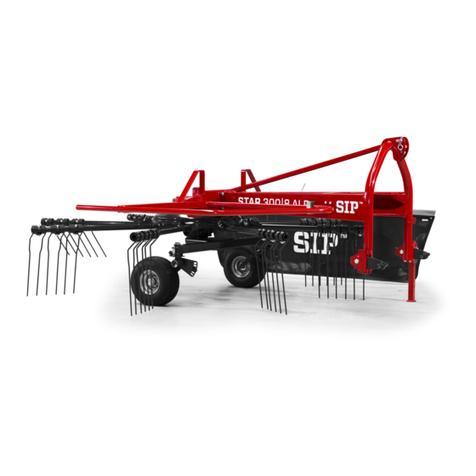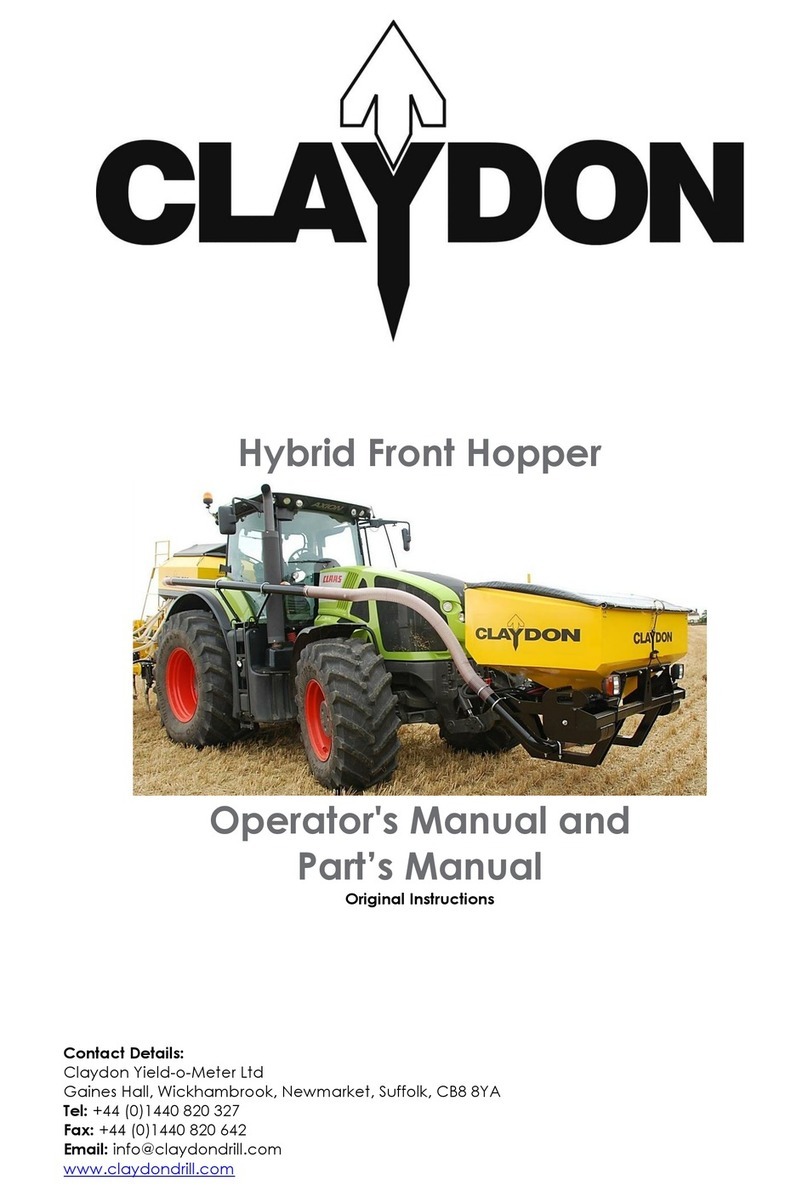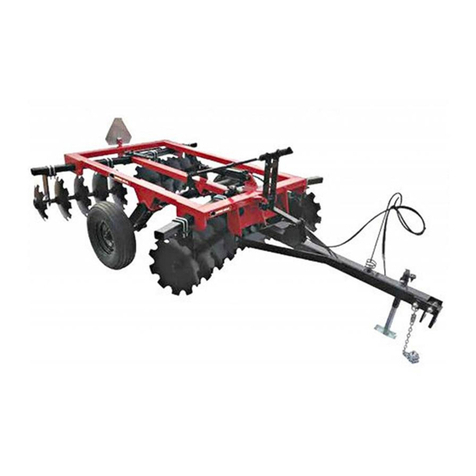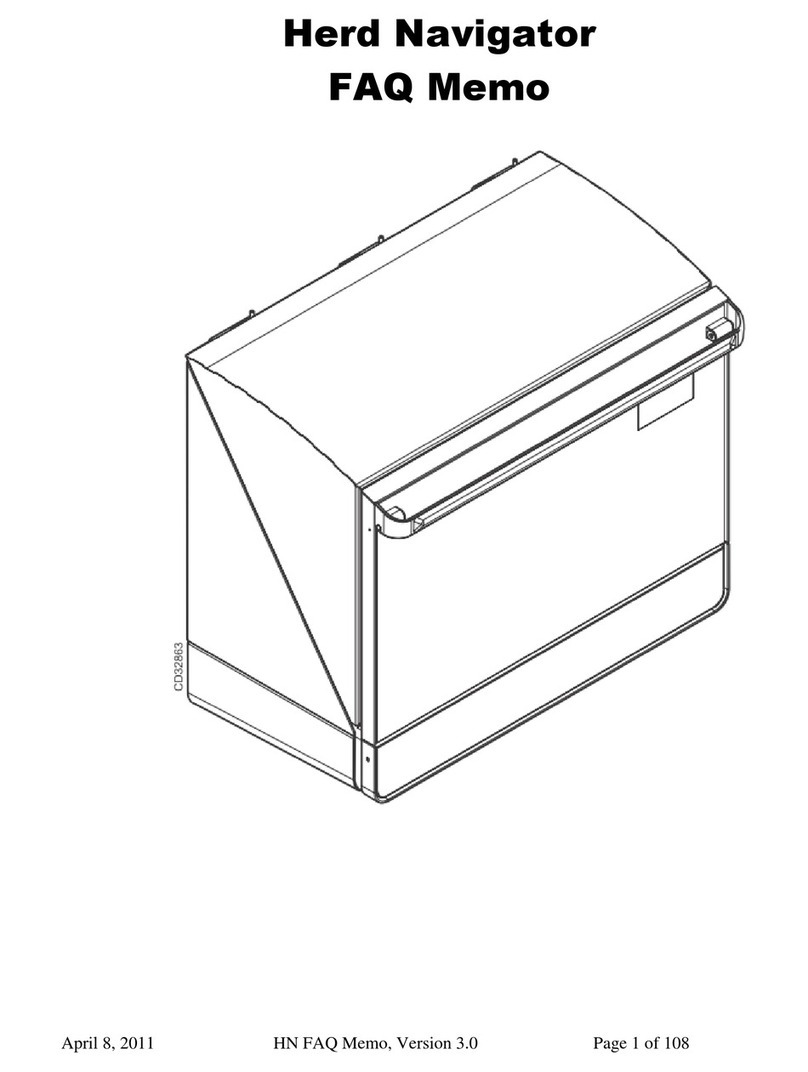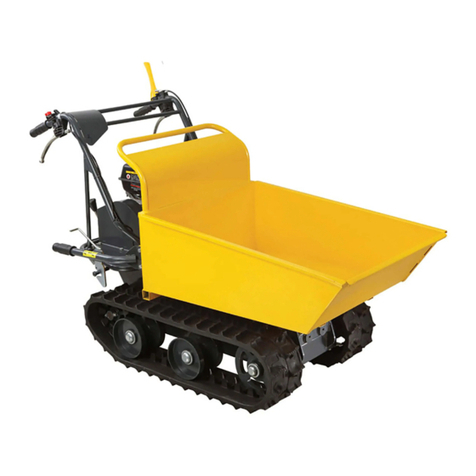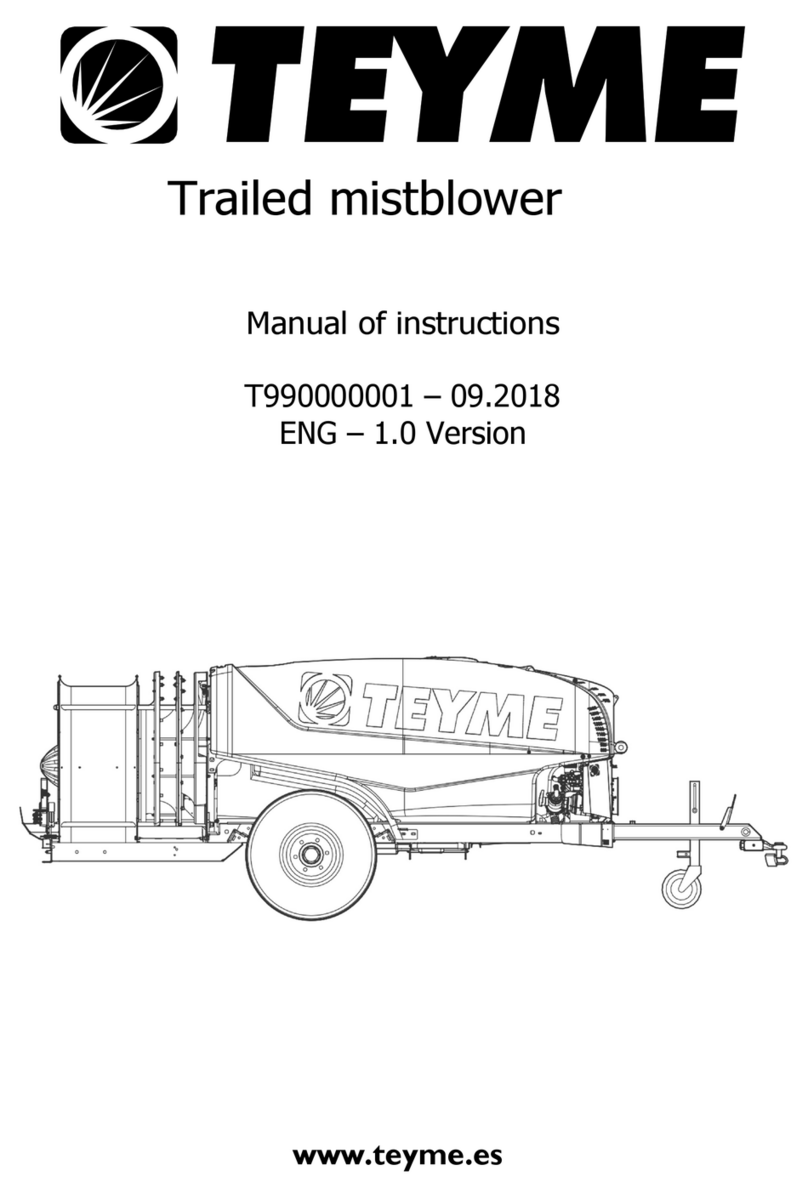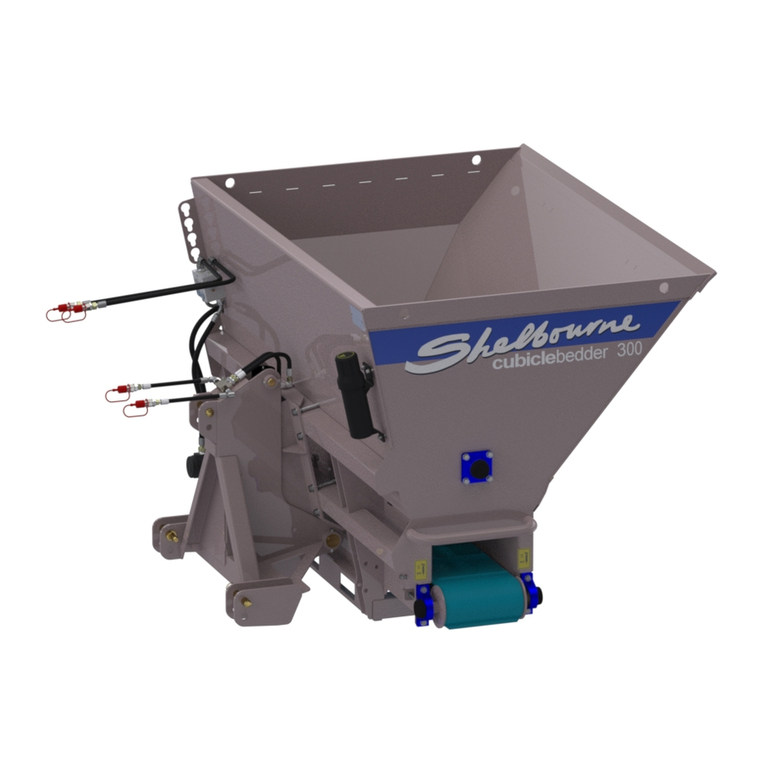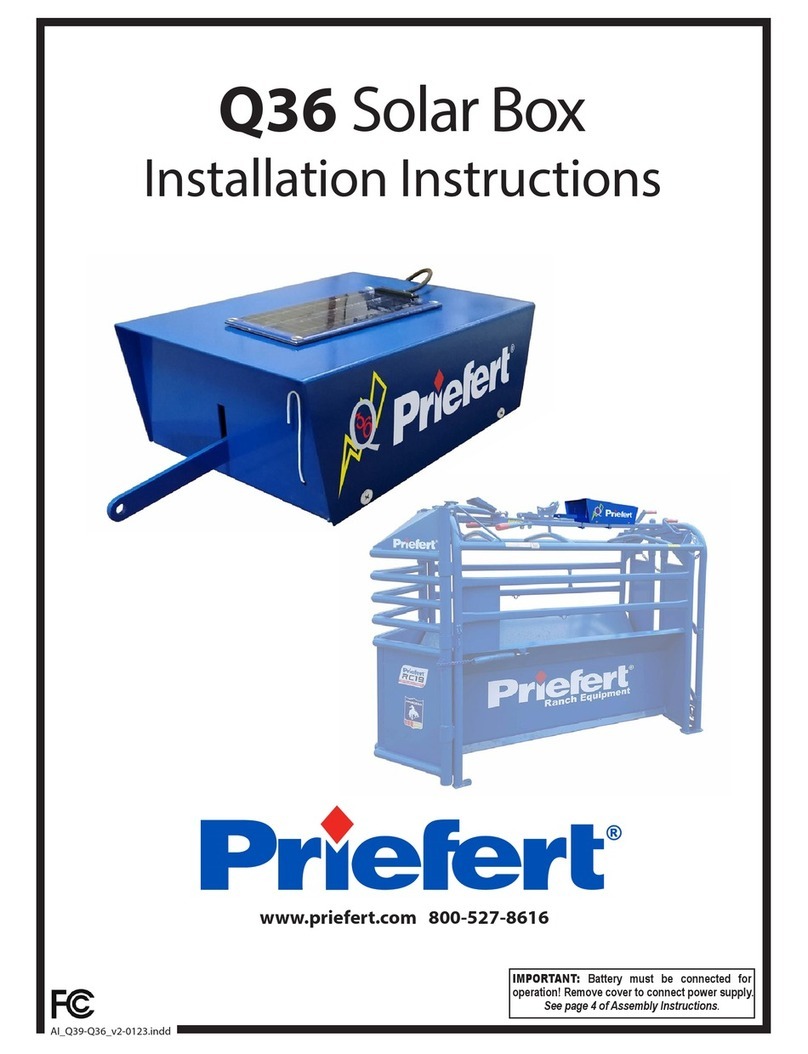Thomas ProTough 300 Screener Owner's manual

Owner’s /
Operator’s
Service and
Parts Manual
Publication No. 52812
September 2005
300 Screener

1
THOMAS EQUIPMENT LIABILITY WARRANTY
THE WARRANTY IS THE ONLY OBLIGATION OF THOMAS OR A
THOMAS DEALER TO THE PURCHASER OR ANYONE ELSE CONCERN-
ING A PRODUCT, ITS SERVICE, ITS USE OR PERFORMANCE OR ITS
LOSS OF USE OR FAILURE TO PERFORM. NEITHER THOMAS NOR A
THOMAS DEALER HAVE MADE AND NEITHER WILL MAKE ANY
OTHER EXPRESSED OR IMPLIED REPRESENTATION, WARRANTY OR
AGREEMENT CONCERNING A PRODUCT, NEITHER THOMAS NOR A
THOMAS DEALER HA
VE MADE OR WILL MAKE ANY REPRESENTA-
TION, WARRANTY OR AGREEMENT CONCERNING A PRODUCTS MER-
CHANTABILITY OR OTHER QUALITY, ITS SUITABILITY FOR PUR-
CHASER’S PURPOSE (EVEN IF APURCHASER HAS INFORMED
THOMAS OR ATHOMAS DEALER OF THAT PURPOSE), ITS DURABILI-
TY, PERFORMANCE OR OTHER CONDITION.
EVEN IF THOMAS OR A THOMAS DEALER WAS ADVISED OF THE
POSSIBILITY OF SUCH LOSS, NEITHER THOMAS NOR A THOMAS
DEALER WILL BE LIABLE TO PURCHASER OR ANYONE ELSE FOR
ANY INDIRECT, INCIDENTAL CONSEQUENTIAL, PUNITIVE, ECONOM-
IC, COMMERCIAL, OR SPECIAL LOSS WHICH IN ANY WAY ASSOCIAT-
ED WITH A PRODUCT. THIS INCLUDES ANY LOSS OF USE OR NON-
PERFORMANCE OF A PRODUCT, ANY REPLACEMENT RENTAL OR
ACQUISITION COST, ANY LOSS OF REVENUE OR PROFITS, ANY FAIL-
URE TO REALIZE EXPECTED SAVINGS, ANY INTEREST COSTS, ANY
IMPAIRMENT OF OTHER GOODS, ANY INCONVENIENCE OR ANY LIA-
BILITY OF THE PURCHASER TO ANY OTHER PERSON.
PURCHASER MAY NOT ATTEMPT TO ENLARGE ITS RIGHTS UNDER
THE WARRANTY BY MAKING CLAIM, FOR INDEMNITY, FOR BREACH
OF CONTRACT, FOR BREACH OF COLLATERAL WARRANTY, FOR A
TORT (INCLUDING NEGLIGENCE, MISREPRESENTATION OR STRICT
LIABILITY) OR BY CLAIMING ANY OTHER CAUSE OF ACTION.
THE WARRANTY IS A CONDITION OF SALE OF THE PRODUCT TO
THE PURCHASER AND WILL THEREFORE APPLY EVEN IF THE PUR-
CHASER ALLEGES THAT THERE IS A TOTAL FAILURE OF THE PROD-
UCT.
N.B. Read and practice your Thomas operating and servicing instructions.
Failure to do this may void the warranty.
PUBLICATION NUMBER 52812
© Thomas Equipment 2004 Inc.
Printed in Canada
INDEX
1. SAFETY PRECAUTIONS
General Instruction............................................................................... 1.1
Decals ................................................................................................... 1.2
Orientation / Access ............................................................................. 1.3
2. CONTROLS
Engine Controls.................................................................................... 2.1
Hydraulic Controls ............................................................................... 2.2
3. OPERATION
Pre - Start Inspection............................................................................ 3.1
Starting Instructions ............................................................................. 3.2
Shut Down Procedure .......................................................................... 3.3
Set - up ................................................................................................. 3.4
Operating Procedures ........................................................................... 3.5
Securing and Transporting ................................................................... 3.6
4. MAINTENANCE
Service Access...................................................................................... 4.1
Preventative Maintenance Schedule .................................................... 4.2
Daily Service Checks ........................................................................... 4.3
150 Hour Service Checks..................................................................... 4.4
300 Hour Service Checks..................................................................... 4.5
500 Hour Service Checks..................................................................... 4.6
900 Hour Service Checks......................................................................4.7
As Required ......................................................................................... 4.8
Electrical Schematic, Chassis .............................................................. 4.9
Electrical Schematic, Engine ............................................................. 4.10
Hydraulic Circuit Schematic .............................................................. 4.11
Trouble Shooting................................................................................ 4.12
5. SPECIFICATIONS
Dimensional Specifications...................................................................5.1
Performance Specifications...................................................................5.2
Fastener Torque Specifications .............................................................5.3
6. REPLACEMENT SCREENS
Screen Selection and Tips ................................................................... 6.1
Replacement Screen Information......................................................... 6.2
7. WARRANTY INFORMATION
Machines Purchased Through Thomas Dealer ................................... 7.1
8. PARTS MANUAL

32
1. SAFETY PRECAUTIONS
The following precautions are suggested to help prevent accidents.
A careful operator is the best operator. Most accidents can be avoided by observing
certain precautions. Read and take the following precautions before operating this
machine to help prevent accidents. Equipment should be operated only by those
who are responsible and instructed to do so.
1.1 GENERAL INSTRUCTIONS
1. Read this manual carefully before using the machine. Working with unfamiliar
equipment can lead to accidents.
2. Do not allow anyone to ride on the machine when being towed.
3. Make sure all safety and instruction decals are in place, and legible. (See sec-
tion 1.2).
OPERATING THE MACHINE
1. Always tow the machine at speeds compatible with safety, especially when
operating over rough ground, crossing ditches or turning.
2. Use care when operating on steep grades to maintain proper stability.
3. Be careful when towing through door openings or under overhead objects.
Always make sure there is sufficient clearance.
4. When travelling on public roads, know the local rules and regulations and
make sure your machine is equipped with the proper safety equipment.
5. Watch out for overhead and underground high-voltage electrical lines when
operating the machine.
6. Always park the machine on firm level ground. If necessary, prepare a level
area to operate the machine from.
7. Be watchful of bystanders when starting and during operation.
8. Wear protective clothing such as safety eye wear, hearing protection, steel toe
foot wear, gloves and hard hats.
9. Never attempt to load the machine in excess of capacity.
10. Assure all hydraulic controls are functioning properly, as well as all safety
devices are installed and functioning at all times.
11. Never run the engine in a closed building without adequate ventilation, as the
fumes can cause death.
12. Never go under the machine while it is operating.
13. Remove debris from the shaker screen before transporting.
MAINTENANCE
1. Stop the engine before performing any service on the machine.
2. Never refuel the machine while smoking or with the engine hot or running.
3. Replace all missing, illegible or damaged safety and warning decals. See sec-
tion 1.2.
4. Do not modify or alter, or permit anyone to modify or alter this machine or any
of its components or machine functions.
5. Do not bypass the safety systems. Consult your Thomas Equipment Dealer if
your safety system is malfunctioning.
6. Do not make mechanical adjustments while the machine is in motion or when
the engine is running.
7. Do not attempt to repair or tighten hydraulic lines when the system is under
pressure. Escaping fluid under pressure can penetrate the skin and cause seri-
ous injury or death.
8. Whenever replacing pivot pins, always use a brass drift and hammer. Failure to
do so could result in injury from flying metal fragments.
9. The cooling system operates under pressure which is controlled by the radiator
cap. It is dangerous to remove the cap while the system is hot. Allow the
engine to cool before removing the radiator cap.
10. Wear protective clothing such as safety eye wear, hearing protection, steel toe
foot wear, gloves and hard hats.
11. The engine RPM (speed), is preset from the factory. Changing the preset speed
may cause severe damage to the shaker components, and will void your war-
ranty.
12. Battery gas can explode. Keep sparks and flames away from batteries. Never
short the battery terminals to check charge. Use a voltage meter or hydrometer.
13. Sulfuric acid in battery electrolyte is poisonous. Fill batteries in a well ventilat-
ed area. Wear eye protection and rubber gloves. Avoid breathing fumes when
charging or when electrolyte is added.
14. For securing and towing instructions, refer to sections 3.6.
15. Dispose of waste responsibly. Improper disposal of waste can harm the envi-
ronment and ecology. Contact your local environmental agency for proper
waste disposal procedures.
Read this manual completely
before attempting to operate this
machine
IMPORTANT
Do not operate this machine if any
protective guards are missing, or
have been removed
WARNING
1. SAFETY PRECAUTIONS

54
46378
S0125
Red Reflective Tape
46154
GREASE 45748
45901
45413
39192
1.2 DECALS
Amber Reflective
Tape 46155
Red/White Reflective Tape
46152
1.2 DECALS
S0124
46164 46164
45413
Amber Reflective Tape
46155
Red Reflective
Tape 46154
45414
TH23308
23308
38043
1. SAFETY PRECAUTIONS 1. SAFETY PRECAUTIONS
Red / White Reflective
Tape 46152
Red / White Reflective
Tape 46152
45413
Red / White Reflective
Tape 46152
Red Reflective
Tape 46154
Red Reflective
Tape 46154
(rear of tubing)
Red Reflective
Tape 46154
39192

76
CAUTION
TH23312
S0144
S0137
23312
23325
46162
45902
TH41064
41064
45903
1.2 DECALS
46369
46370
Red / White Reflective Stripe 46152
White Reflective
Stripe 46153
Amber Reflective Tape 46155
GREASE 45748
47061
1.2 DECALS
47062
45413
46163
39192
46181
1. SAFETY PRECAUTIONS1. SAFETY PRECAUTIONS
GREASE
45748

98
1.3 (continued)
Shaker deck/head
Shaker motor box
Axle lift cylinder
Front cylinder jack control
Crown bar (3)
Front cylinder jack
Axle lock
Axle
S0024
S0124 S0031
S0136
Top wire cloth
Bottom
wire cloth
Hydraulic oil tank
Fuel tank
S0135
Shaker Motor
Shaker motor box
Crown bar rubber (3)
Spring
1.3 ORIENTATION / ACCESS
The following will familiarize you with the technical terms and location of impor-
tant components. Major components, control locations and indicator or instruments
can be located using the pictures provided.
Details of control operations and functions are explained in the Operations Section
3.
S0144
S0125
S0124
Hydraulic fill
Top wire cloth
Bottom wire cloth
Hopper
Hitch
Shaker spring
Shaker deck / head
Shaker deck / head
Engine / Hydraulic
compartment
S0141
Engine access Fuel fill inside
engine compartment
Control access
Oil fill
Muffler
Oil filter
Battery
Fuel filter
Coolant overflow
Oil level dip stick
Air cleaner
Engine control and
instrument panel
Shaker and rear
axle lift control
Engine throttle control
Axle lock lift control
S0127 S0137
Tethered trailer
brake switch
Trailer electrical
connector
1. SAFETY PRECAUTIONS 1. SAFETY PRECAUTIONS
Shaker shaft

11
2. CONTROLS
10
Engine Controls .................................................... 2.1
Hydraulic and Axle Controls ................................ 2.2

1312
2.1 ENGINE CONTROLS (continued)
S/N T3000358 ONWARD
Instrument Panel: (S0270)
A. Oil pressure. This red indicator, when
on means that the engine is not running.
When it is flashing there is an oil pressure
problem and the engine will shutdown. If it
is off, the oil pressure is within limits.
B. Coolant temperature. This red indi-
cator will illuminate whenever the engine
coolant temperature exceeds the maximum
recommended level.
C. Charging. This amber indicator illu-
minates when there is an alternator problem.
When it is off the alternator is charging.
D. Glow plugs. This indicator will illu-
minate whenever the engine plow plug pre-
heaters are engaged. If it is flashing, the
preheating is done and the engine is ready
to start. When the indicator is off, the pre-
heat is off.
E. Hour meter. The hour meter mea-
sures actual engine operating hours.
F. Ignition switch. The ignition switch
controls engine preheat, start, run and stop
functions.
Throttle: (fig. S0096, S0097).
Push throttle back for start and stop
functions. Pull toward you and push into
notch to engage operating speed.
2.2 HYDRAULIC and AXLE LOCK
CONTROLS (fig. S0049)
A. Axle lock lift. Pushing the lever
back raises the axle lock device. The engine
needs to be operating and the hydraulic
axle lift needs to be engaged to release the
axle lock from its support brackets as you
push the lever.
B. Hydraulic axle lift control. Push to
lower the machine. Pull to raise to transport
position.
C. Hydraulic shaker control. Push to
engage shaker. Pull to stop shaker.
S0270
Instrument panel
A
E
2. CONTROLS
2.1 ENGINE CONTROLS
UP TO S/N T3000357
Instrument Panel: (S0048)
A. Low oil. This indicator will illumi-
nate whenever the engine oil pressure drops
below the minimum recommended level.
B. High temp. This indicator will illu-
minate whenever engine coolant tempera-
ture exceeds maximum recommended level.
C. Battery charge. This indicator illu-
minates whenever the charging system is
under or over charging.
D. Glow. This indicator will illuminate
whenever the engine glow plug preheaters
are engaged.
E. Hour meter. The hour meter mea-
sures actual engine operating hours.
F. Ignition switch. The ignition switch
controls engine preheat, start, run and stop
functions.
G. Circuit breaker. The button pops out
when electrical circuit overload occurs.
Push to reset.
Throttle: (fig. S0096, S0097).
Push throttle back for start and stop
functions. Pull toward you and push into
notch to engage operating speed.
S0048
S0096
Instrument panel
S0049
S0097
Engine throttle control, idle position
Engine throttle control, run position
A
BC
A
B
C
D
E
F
G
2. CONTROLS
B
C
D
S0096
S0097
Engine throttle control, idle position
Engine throttle control, run position
F

1514
Pre - Start Inspection................................................ 3.1
Starting Instructions ................................................ 3.2
Shut Down Procedure .............................................. 3.3
Set - up .................................................................... 3.4
Operating Procedures .............................................. 3.5
General ............................................................3.5A
Loading Material ............................................3.5B
Removing Finished Material ..........................3.5C
Removing Tailings (Rough) Material ............3.5D
Screening Selection / Combination ................3.5E
Securing and Transporting ...................................... 3.6
3. OPERATION

1716
2. Check all hydraulic hoses for chaffing,
bulges and leaks. Replace immediately
if defects are found.
3. Verify hydraulic controls are in the neu-
tral position before starting the engine.
Shakerhead:
1. Grease shakerhead bearings. Assure
bearing hardware is tight (fig. S0146).
2. Check shaker spring mounting hardware
for tightness (fig. S0124). Follow the
procedure in section 4.
3. Check shaker springs for cracks
(S0124).
4. Verify there is no debris on the shaker
screens and check for bystanders before
start - up.
5. Check the shaker screens and holddown
mounting hardware for proper tension
(fig. S0124). See section 4.
S0146
S0124
S0055
Grease bearings
Check bolts
Low level
Check screen tension
Check springs (8)
S0156
Check bolts
Operating level
Never repair or tighten hydraulic hoses
or fittings while the machine is run-
ning. Fluid under pressure can pene-
trate the skin and cause serious injury.
WARNING
Verify there is no debris on the shaker
screens and check for bystanders
before start - up.
WARNING
Bottom screen
3.1 PRE - START INSPECTION
A daily inspection should be performed to
ensure safe operation and minimal down
time.
The daily maintenance should be per-
formed before start - up. See Section 4 for
complete details.
Engine:
1. Check the fuel level. Add fuel if neces-
sary. Make sure the filler cap is secure.
2. Inspect fuel lines for leaks.
3. Check air cleaner restriction indicator,
air intake hoses and clamps. Assure
everything is tight and no hoses are
chaffed or have holes in them.
4. Check engine oil level.
5. Check engine coolant level.
6. Check engine fan belt.
7. Check radiator cooling fins for obstruc-
tion(s). Flush if necessary.
8. Check the hour meter reading. Have
scheduled maintenance performed if
required. Refer to section 4.
9. Verify compartment cover and doors are
closed and secured.
Hydraulics:
1. Check the fluid level. Add 10 W 30
motor oil as required to bring fluid level
in the middle of the site gauge (fig.
S0055). Make sure the filler cap is
secure.
S0145
S0144
S0137
S0138
Air restriction indicator
Fuel fill
Check
Check hour meter
Air cleaner
Inside engine compartment
3. OPERATION 3. OPERATION

1918
3.2 STARTING INSTRUCTIONS
(continued)
7. Allow the engine to warm up 15 min-
utes at the idle position before operat-
ing at the normal operating speed.
8. Check the instrument panel gauges and
indicators for normal operation. Shut
the engine off immediately if warning
indicators are illuminated.
3.3 SHUT DOWN PROCEDURE
1. Make sure the shakerhead control lever
is in the neutral position and the shak-
erhead has stopped.
2. Move the throttle control to the idle
position and allow the engine to cool
for approximately 2 minutes.
3. Turn the ignition key counter clockwise
to the stop position.
4. Clear any debris that may still be stuck
to the shaker screens.
The engine idle position is used for
engine start up, cool down, wheel lift
and jack operations. DO NOT operate
at high idle settings while performing
these operations. Damage or injury
may occur to the machine and or the
operator.
WARNING
Follow the operation procedures in
Section 3.4 before engaging the shaker-
head.
IMPORTANT
This machine is a equipped with an
engine monitoring system that will shut
down the engine whenever engine oil
pressure is too low, or coolant tempera-
ture is too high. The warning lights illu-
minate to notify whenever a problem
occurs. Have the problem diagnosed
and repaired before further operation.
IMPORTANT
Allow the engine to warm approxi-
mately 15 minutes before engaging the
shaker control. If the engine labors
when trying to engage the shakerhead,
allow the engine to warm an additional
5 minutes, then try again.
IMPORTANT
3.2 STARTING INSTRUCTIONS
1. Perform the pre - starting inspection at
the beginning of this section.
2. Ensure the hydraulic controls are in the
neutral position (S0137).
3. Place the engine throttle control in the
low idle position.
4. Make sure bystanders are clear of area.
5. Preheat the engine glow plugs, turn the
ignition key counter clockwise, for 10
seconds (S0270a).
6. Engage the engine starter by turning the
ignition key fully to the clockwise posi-
tion (S0270b). Release when the engine
has started.
Do not engage the starter for more than
15 seconds intervals. Repeat the pre-
heat procedure if the engine fails to
start. Allow the starter to cool to ambi-
ent temperature after 3 consecutive
starting attempts. Failure to do so may
cause premature starter and / or engine
stop solenoid failure.
IMPORTANT
This engine is equipped with glow plug
type preheaters. Do not use ether or
high energy fuels to assist starting.
Severe engine damage may result.
CAUTION
S0137
S0270b
S0270a
Hydraulic controls to neutral
Throttle to idle
Preheat engine glow plugs
Engage starter
3. OPERATION 3. OPERATION

2120
5. Release the axle lock mechanism,
(C3171), by raising the rear of the
machine up, and pushing the axle lock
lever (S0059). Lower the machine to the
ground as you release the axle locks
from their support brackets. Raise the
wheels to their fully raised position.
6. Engage full engine speed.
7. Engage the hydraulic shaker control. S0090
C3172
S0056
S0059
Axle lock control
Axle lift control
Push
Allow the engine to warm approxi-
mately 15 minutes before engaging the
shaker control. If the engine labors
when trying to engage the shakerhead,
allow the engine to warm an additional
5 minutes, then try again.
IMPORTANT
When engaging the shaker control,
ensure the engine is at full operating
speed.
IMPORTANT
Axle Locks
Axle Locks Supports
3.4 SET UP
Follow the pre- starting inspection and
start up instruction previous to this section.
The machine must be operated on a level
surface. If necessary, grade an area to
accommodate.
Make sure you leave adequate room for
maneuvering equipment around the
machine to remove tailings.
For efficient cycle times, keep the stock
piles as close as possible to prevent exces-
sive travel times.
1. Start the engine and operate at the
idle position.
2. Engage the front hydraulic jack
(S0031). Lower to the ground enough to
remove tongue weight from the pintle
hitch. Release the pintle hitch.
3. Disconnect the electrical harness and
tethered breakaway switch from the tow
vehicle.
4. Raise the hydraulic jack to lower the
machine to the ground. Make sure
bystanders and your feet are clear when
the machine is lowered.
Make sure the area around you is clear
when lowering the machine to the
ground. Make sure bystanders and
your feet are clear when the machine is
lowered.
WARNING
S0031
S0032
S0023
S0137
Front hydraulic jack
Disconnect electrical
Disconnect pintle hitch
Set up at idle speed
3. OPERATION 3. OPERATION

2322
3.5B Loading Procedure
When loading material into the hopper,
keep the bucket as low as possible (fig.
S0010). Allow the material to slide down
the high side of the hopper plate onto the
top screen deck.
Check tailings for size. If you find good
material mixed in with the tailings, try
slowing the feed rate (dump) into the hop-
per.
Dumping the material further down the
deck wastes processing area (fig. S0011).
This will allow good material to flow off
with the tailings.
Use extra care when placing large
heavy objects on the top screen deck. Make
sure smaller material is in front of the load
before lowering onto the top screen deck.
This will provide some cushion effect.
Never drop large heavy objects directly
onto the top screen deck (fig. S0012).
Immediate damage to the wire screen cloth
or shaker assembly may occur.
Keep an eye on tailings and finished
product. Do not allow to build up around
the shaker deck area. Retrieve product
before excessive build up around the shaker
area.
S0010
S0011
S0012
Hopper high side
Wasted processing area
Large objects may roll uncon-
trollably off the top screen deck.
Assure the area where tailings are
being discharged has adequate run off
area.
WARNING
3.5 OPERATING PROCEDURES
Follow the set up procedures outlined
previous to this section.
This section contains important infor-
mation for getting the best performance
and efficiency from your machine.
3.5A. General
The shakerhead assembly contains two
sorting surfaces called screens. Certain
application will require you to change
screen sizes for best results. There are a
number of screen sizes, and multiple com-
binations are available to sort varied mater-
ial. Proper screen sizing makes this a truly
multipurpose and efficient machine, able to
handle fine sands, rock, wood product
refuse, etc.
The basic rule of thumb for screen siz-
ing is a 3 to 1 ratio, top to bottom respec-
tively. Example: 3’’ (76mm) top screen,
1’’ (25mm) bottom screen. However, in
some cases, it may be more efficient to run
the material through a larger screen combi-
nation first, then changing the screens to
obtain the final product size. This would be
desirable when the material being sized
clogs the screens or feed rate becomes
excessively slow.
The most common type of screen mate-
rial is called “wire cloth”. Various diame-
ters of wire are overlaid together to make
varied openings. The actual diameter of the
wire used dictates the surface area of the
hole.
Example: A screen 2’’ square, using a
0.25 wire diameter would have a larger
hole opening than a 2’’ square using 0.50
wire diameter. The smaller diameter screen
will be more efficient, due to the larger
open area, but screen life will also be short-
er. A larger wire diameter material will
wear longer.
Wire cloth screens may be ordered in
square or rectangular (slotted) pattern.
Select the proper screen for your applica-
tion. A slotted pattern will process material
faster, though larger material will slip
through.
See Section 6 for more screen size
information.
3. OPERATION 3. OPERATION

2524
3.5D. Removing Tailings
Do not allow the tailing to pile up high-
er than the shaker deck area.
Remove tailings by pushing the materi-
al from the side of the machine (fig.
S0007).
Do not use the machine as a back stop
(fig. S0008).
S0007
S0008
Allowing excessive material to pile up
under the shaker deck may cause seri-
ous damage to the machine.
CAUTION
3.5C Removing Finished Material
After each load is placed into the hop-
per, check the finished and tailing piles.
Allow adequate area to retrieve finished
material from under the hopper and shaker
deck area (fig. S0004).
For best efficiency, allow at least a full
bucket of material to accumulate before
retrieving.
Do not allow the product to pile up
around the shaker deck area (fig. S0005).
This will impede the shaker action and
could result in serious damage to the shaker
deck assembly.
Retrieve finished material from under
the high hopper side area (fig. S0006).
Drive into the material with the bucket low.
Use the screener as a back stop, curling the
bucket before you contact the deflector
plate (fig. S0006).
Do not raise the bucket excessively as
to contact the shaker deck assembly (fig.
S0009). Serious damage may occur.
S0004
S0005
S0006
S0009
Allowing excessive material to pile up
under the shaker deck may cause seri-
ous damage to the machine.
CAUTION
3. OPERATION 3. OPERATION

2726
3.6 TRANSPORTING
Before transporting the machine, per-
form the following checks.
Tire pressure 80 psi (551 kPa).
Wheel nuts torqued 190 ~ 210 lbs. / ft.
(258 ~ 286 Nm.). Check the wheel nut
torque after 50 miles (80 Km), and again at
100 miles (62 Km). Check before each site
move thereafter.
Check axle grease (S0061). The grease
should be level with the check plug.
Check the pintle hitch mounting bolts
and the safety chains.
This machine is equipped with self
adjusting 12 volt electrically activated
brakes. For safety, the system has its own
12 volt battery source to activate the wheel
brakes whenever the tethered break away
switch has been activated. This means, if
the machine has unhitched from the tow
vehicle, the brakes will activate automati-
cally, if the tethered break away switch has
been secured to the tow vehicle and the 12
volt battery source is operative.
Check the electrically activated brakes
using the breakaway switch. Refer to sec-
tion 4.3G.
Check the axle lock device. Make sure
it is securely located in the axle lock sup-
port brackets (fig. S0024)
Verify the clearance marker and indica-
tor lights are all functioning. Repair imme-
diately if defective.
Always clean all debris from the
screener before transporting. This will pre-
vent debris from interfering with other traf-
fic.
S0024
S0061
S0032
S0023
Check wheels, tires and axle grease
Pintle hitch bolts
Safety chains
Breakaway switch
Axle lock
Axle lock supports
Tether cable
Clean debris from the shaker decks
before transporting.
WARNING
3.5E. Screening Selection / Combinations
The top plate or screen is used to
absorb the impact of heavier material and
discharge or separate the larger material to
a separate pile.
The bottom screen further separates
materials and dictates the actual final size
of product.
The correct combination of screen sizes
will produce the desired size of material
quickly and efficiently (S0001). Results;
high yield.
A top screen with too small an opening
will process material inefficiency and
usable material will be lost to waste.
(S0002). Results; low yield.
A top screen with too large an opening,
or if the bottom screen size is small, will
clog the bottom screen (S0003). Results;
low yield.
Proper loading technique is also impor-
tant for efficient operation. Slowing the
feed rate into the hopper will allow more
time for the material to separate.
Situations when the lower screen deck
continues to clog, a larger bottom screen
may need to be used and the material run
through a second time with a smaller
screen. This may prove to be more effective
than slowing the feed (dumping) rate exces-
sively.
S0001Proper screen selection
Top screen selection too small
Top screen selection too large, bottom
too small
S0003
S0002
3. OPERATION 3. OPERATION

29
4. MAINTENANCE
28
Service Access Areas ............................................ 4.1
Preventative Maintenance Schedule ..................... 4.2
Daily Service...........................................................4.3
Screen Tension ..............................................4.3A
Shaker Springs...............................................4.3B
Engine............................................................4.3C
Hydraulic System..........................................4.3D
Safety System ................................................4.3E
Lubrication.....................................................4.3F
Brake System, Trailing Axle.........................4.3G
Electrical Schematic -
Charger and Break Away Switch ...........4.3H
150 Hour Service ....................................................4.4
Engine Oil and Filter.....................................4.4A
Engine Fuel System.......................................4.4B
Engine Air Filter............................................4.4C
Engine Fan Belt.............................................4.4D
Engine Cooling System .................................4.4E
Shaker Shaft...................................................4.4F
Hydraulic System..........................................4.4G
Chassis Maintenance.....................................4.4H
300 Hour Service ....................................................4.5
Fuel Filter......................................................4.5A
500 Hour Service ....................................................4.6
Engine Valve Clearance (lash) ......................4.6A
900 Hour Service ....................................................4.7
Engine Cooling System.................................4.7A
Hydraulic System ..........................................4.7B
As Required.............................................................4.8
Screen Replacement......................................4.8A
Electrical Circuit Schematic, Chassis .....................4.9
Electrical Circuit Schematic, Engine ....................4.10
Hydraulic System Schematic ................................4.11
Trouble Shooting...................................................4.12
Screener.......................................................4.12A
Engine..........................................................4.12B

3130
SERVICE ACCESS (continued)
S0064
Remove panel for
Hydraulic
oil fill
S0031
S0063
S0044
Grease points
Spring bolts
Grease point,
Shaker bearing
Counterweight
Shaker shaft
Shaker motor
Shaker motor
coupling
Fuel shut off and tank drains
Fuel tank drain
Fuel line shut off
Hydraulic oil tank drain
Spring bolts
SO162 SO161
SERVICE ACCESS
The following page(s) will depict how to access specific areas for service.
S0144
S0143
S0024
Oil fill
Muffler
Oil filter
Battery
Fuel filter
Coolant overflow
Oil level dip stick
Air cleaner
Hydraulic oil cooler
Engine air
precleaner
S0066
Grease points
Engine oil drain
S0141
Engine access
Fuel fill inside
engine compartment
Control access
4. MAINTENANCE 4. MAINTENANCE

3332
4.3 DAILY SERVICE
4.3A. Screen Tension
To prevent premature screen or crown
bar rubber wear:
Every 4 hours of operation, check the
crown bar rubber on the top and bottom
screens. (S0051) Make sure it is intact and
not damaged. If necessary, replace.
Every 4 hours, torque the bolts retain-
ing the screens to the screen deck. Start
from the middle, tighten the bolts in a criss
- cross pattern to 45 lbs. / ft (61.2 Nm) (fig.
S0014, S0062, S0034).
Assure the screens are tight against the
crown bar rubbers. If necessary, tighten the
bolts further, in 5 lbs. / ft. (6.8 Nm) incre-
ments, until the screen is tight against the
crown bar rubbers.
Start the engine and engage the shaker
to verify. (Refer to section 3 for operating
instructions). The screens must not bounce
freely on the crown bar rubbers. This will
decrease the life of the screens. You will
notice if the screens are loose by the rap-
ping noise they will make. If necessary,
tighten the bolts further, in 5 lbs. / ft. (6.8
Nm) increments, until the screen is tight
against the crown bar rubbers and they do
not bounce when the shaker is engaged.
S0014
S0062
1
1
2
2
3
3
4
4
56
78
Screen bolt tightening sequence
Crown bar rubbers
Top screen bolts
Bottom screen bolts
S0034
When performing maintenance, assure
the engine is off and the ignition key is
removed to prevent accidental start up.
WARNING
SO164
Note: A complete 150 Hour service is to be performed initially at 50
Hours.
ITEM SERVICE REQUIRED
Screen tension Give a quick visual check to the tension. If
loose, adjust the tension. See section 4.
Spring Bolts Check the spring bolt tension. See section
4.
Engine Oil Check level. Add if required. Use mini-
mum API class CF oil.
Radiator Check level. If required, fill with 50 / 50
mix of ethylene glycol and water. Check
cooling fins for obstruction. Flush with
compressed air and / or water.
Hydraulic Oil Check level. Add 10 W 30 motor oil as
required.
Air Cleaner Check air restriction indicator.
Replacement only.
Safety Equipment Check all safety equipment is secure.
Decals Check all decals are intact and legible.
Lubrication Grease bearings and pivot points.
Tires and Wheels Check air pressure and wheel nut torque
every 50 hours or before each transport.
50 Hour Service Perform complete 150 Hour service. Initial
service only. See section 4.
Engine Oil, Filter and Initial change only.
Fuel Filter
Hydraulic Oil Filter Initial change only.
Preventative Service Perform complete 150 Hour service.
Repeat every 150 hours. See section 4.
Engine Oil and Filter Change.
Hydraulic Oil Filter Change.
Drive System Check mounting bolts, coupling alignment
and condition.
Engine Fuel Filter Change.
Hydraulic Oil and Filter Change.
Engine Coolant Drain, flush and refill.
Hydraulic Reservoir Replace suction element.
4 HOURS
8 HOURS
50 HOURS
150 HOURS
300 HOURS
900 HOURS
Note: For complete engine service details refer to Engine Repair Manual 43370.
4. MAINTENANCE 4. MAINTENANCE

35
4.3C. Engine
Check engine compartment area for
signs of fluid leaks (S0144).
Check the engine oil level. Add mini-
mum API classification CF 10W30 oil if
required (fig. C642).
Check coolant level. Add 50 / 50 mix-
ture of ethylene glycol and water if
required (S0144).
Check and clean radiator cooling fins
for obstructions. Flush with compressed air
and / or water.
Check the air intake hoses and clamps.
Make sure clamps are tight and no hoses
are chaffed.
Check the air restriction indicator.
Replace the element if the indicator shows
red color (S0145).
Check battery terminal connections.
Make sure the battery is fastened securely
to its’ compartment.
C642
S0144
S0144
Do not exceed 40 psi (276 kPa) when
servicing the radiator. Wear safety
glasses when using compressed air.
Wear rubber gloves when working
with coolant.
WARNING
Add coolant
Coolant level
Engine compartment
Never attempt to clean and reuse the
air filter elements. Damage can occur
to the paper pleats causing dirt to enter
the engine.
IMPORTANT
S0145
Air restriction indicator
34
4.3 DAILY SERVICE
4.3B Shaker Spring Bolts
Check the 16 shaker spring mounting
bolts every 4 hours of operation.
Check to make sure the spring rubbers
and spacer blocks are in place (fig. S0013).
Loosen the locking nuts on the bolts.
Use a wrench to make sure the bolts are
hand tight to begin.
Using a torque wrench, start at any bolt
and torque to 180 lbs. / ft. (245 Nm).
Continue in a circular pattern tightening the
other 15 bolts.
Increase torque setting to 200 lbs. / ft.
(272 Nm), repeat the tightening pattern.
Increase torque setting to 225 lbs. / ft.
(306 Nm), repeat the tightening pattern.
Tighten the locking nuts on the bolts
against the frame.
S0013
S0165
Spring assembly
Shaker springs and bolts
Rubber pad
Steel block
When performing maintenance, assure
the engine is off and the ignition key is
removed to prevent accidental start up.
WARNING
4. MAINTENANCE 4. MAINTENANCE

37
4.3 DAILY SERVICE
4.3F Lubrication
There are ten (10) lubrication points on
this machine that require regular service.
Use a high quality lithium based grease.
Apply two (2) shots per grease fitting.
The two (2) shaker drive shaft bearings
require daily lubrication, or every eight (8)
hours of operation, which ever comes first
(S00146).
The hydraulic lift cylinders, one front
one rear, have two (2) grease fittings each
(S0024, S0031). Grease each before trans-
porting to new site.
The axle lock mechanism has two (2)
grease fittings that require lubrication
before transporting (S0024).
The axle pivot mechanism has two (2)
grease fittings that require lubrication
before transporting (S0024).
S0146
S0024
S0031
Shaker shaft bearing
(one each side)
Lubricate
Lubricate
Lubricate
When performing maintenance, ensure
the engine is off and the ignition key is
removed to prevent accidental start up.
WARNING
4. MAINTENANCE
36
4.3E Safety Equipment
Ensure all safety, warning and instruc-
tion decals are in place and legible. See
section 1.2 for decal placements.
Make sure all compartment doors are
closed and secured before operating.
Also check all shields, lights, brakes,
and safety chains.
4.3 DAILY SERVICE
4.3D Hydraulic System
Check hydraulic hoses, pumps and
motors for leaks (S0067, S0068). Check
each hydraulic hose for chaffing or bulging.
Replace immediately as required.
Check the hydraulic fluid level (S0055).
Fill to the middle level on site gauge with
10 W 30, minimum API classification SJ
motor oil.
Check the hydraulic oil cooler fins for
obstructions (S0050). Clean with com-
pressed air and or flush with water.
Do not exceed 40 psi (276 kPa) when
servicing the radiator and oil cooler.
Wear safety glasses when using com-
pressed air.
WARNING
S0067
S0055
S0068
S0166
Hydraulic oil level site gauge
Minimum level
Hydraulic oil cooler
Hydraulic shaker motor
Hydraulic gear pump
Never repair or tighten hydraulic hoses
or fittings while the machine is run-
ning. Fluid under pressure can pene-
trate the skin and cause serious injury.
WARNING
4. MAINTENANCE
Table of contents
Other Thomas Farm Equipment manuals
Popular Farm Equipment manuals by other brands

LELY
LELY HIBISCUS 735 Vario Handleiding Operator's Manual
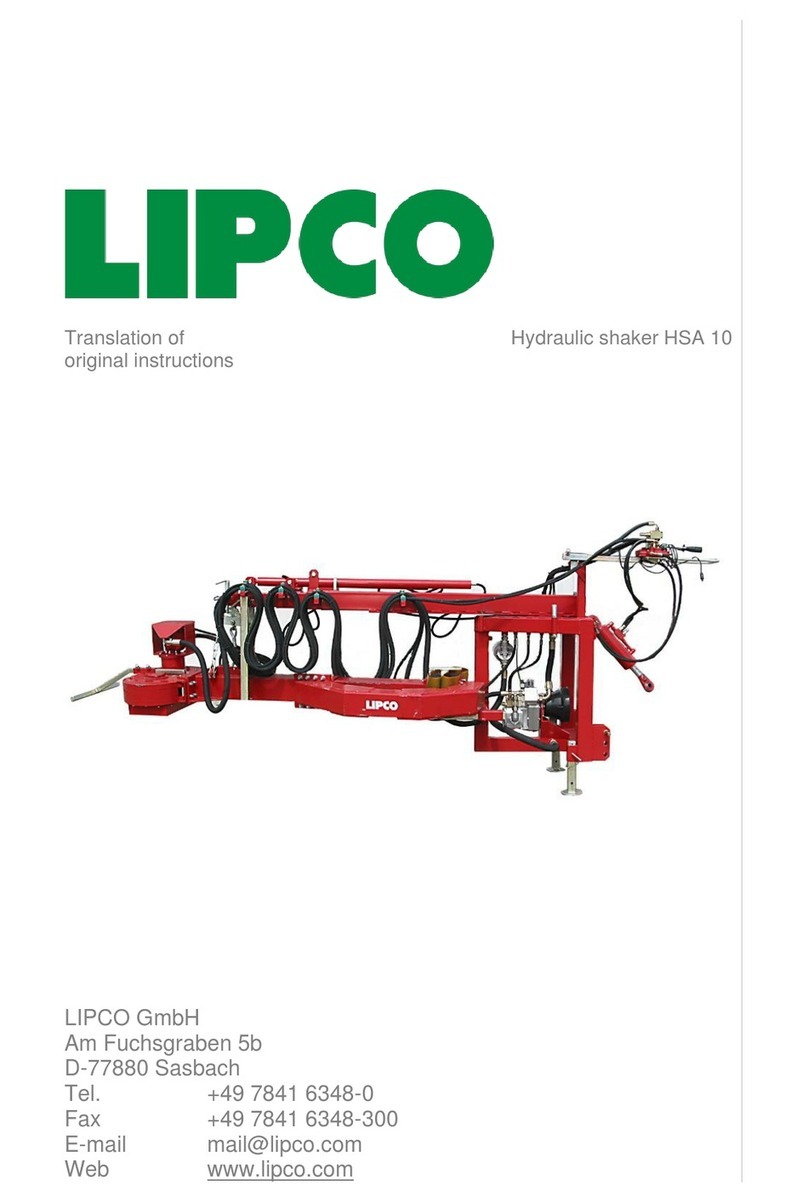
Lipco
Lipco HSA 10 manual
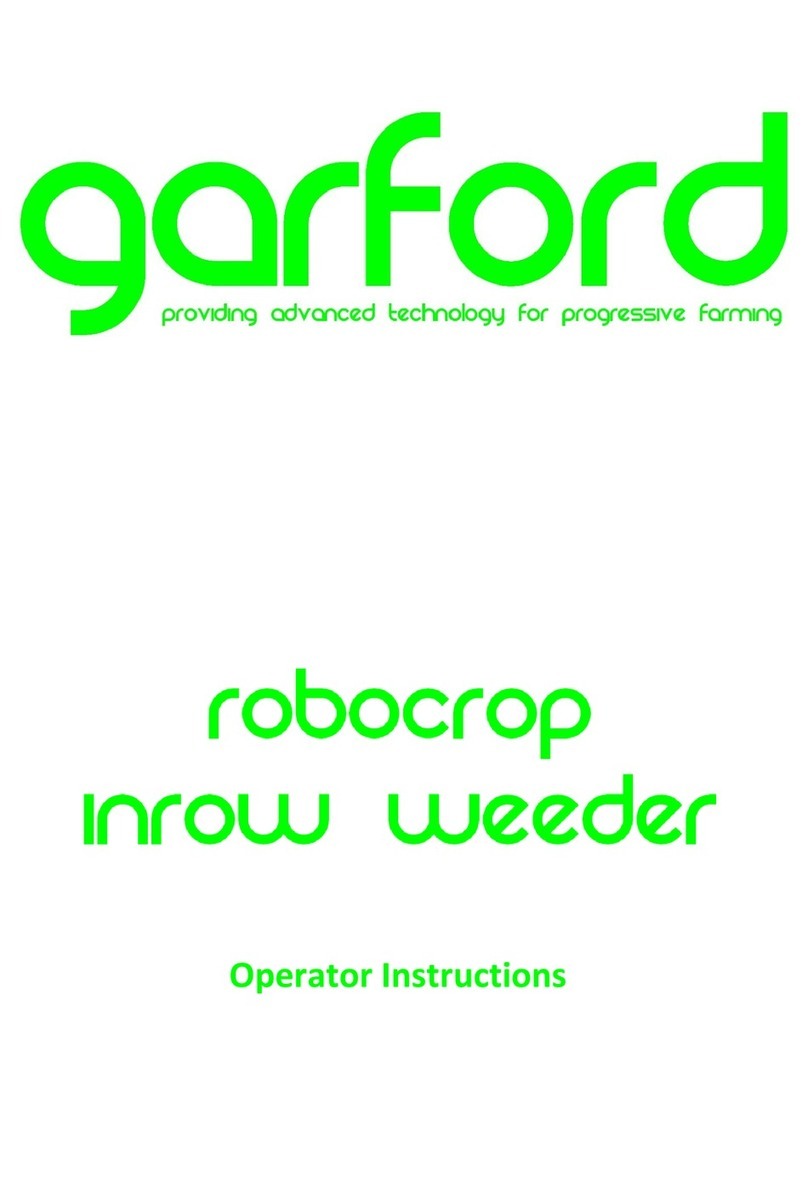
Garford
Garford Robocrop Inrow Weeder Operator instructions
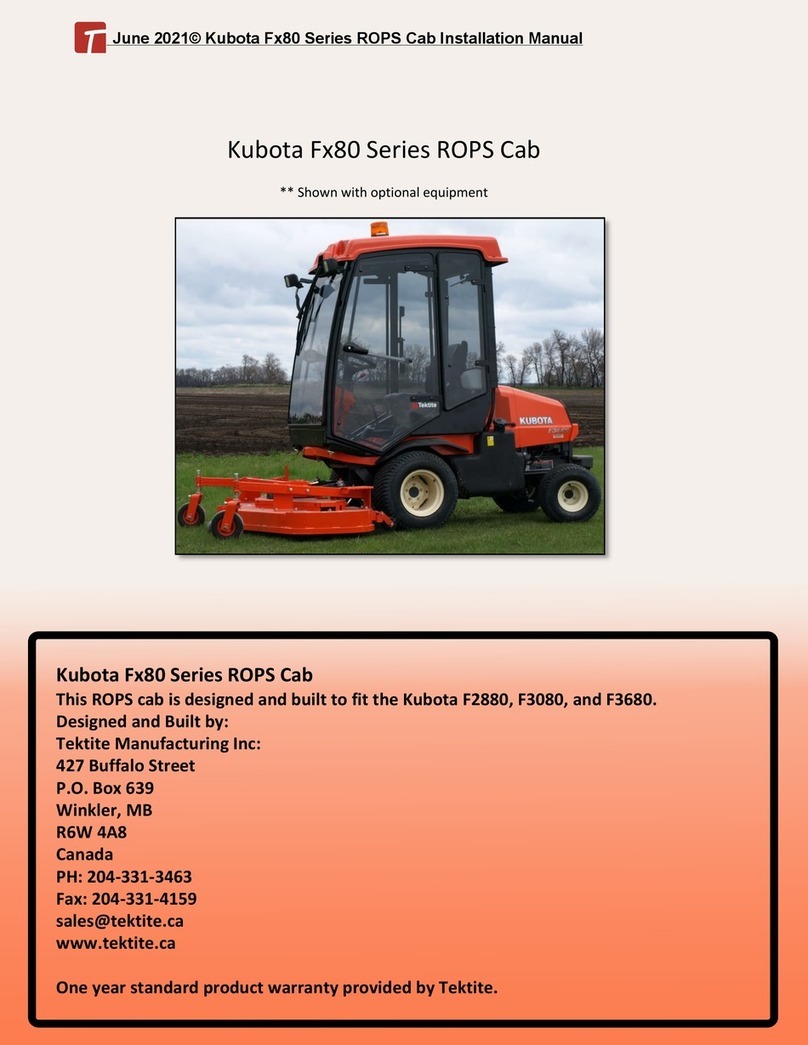
Kubota
Kubota ROPS Cab F 80 Series installation manual
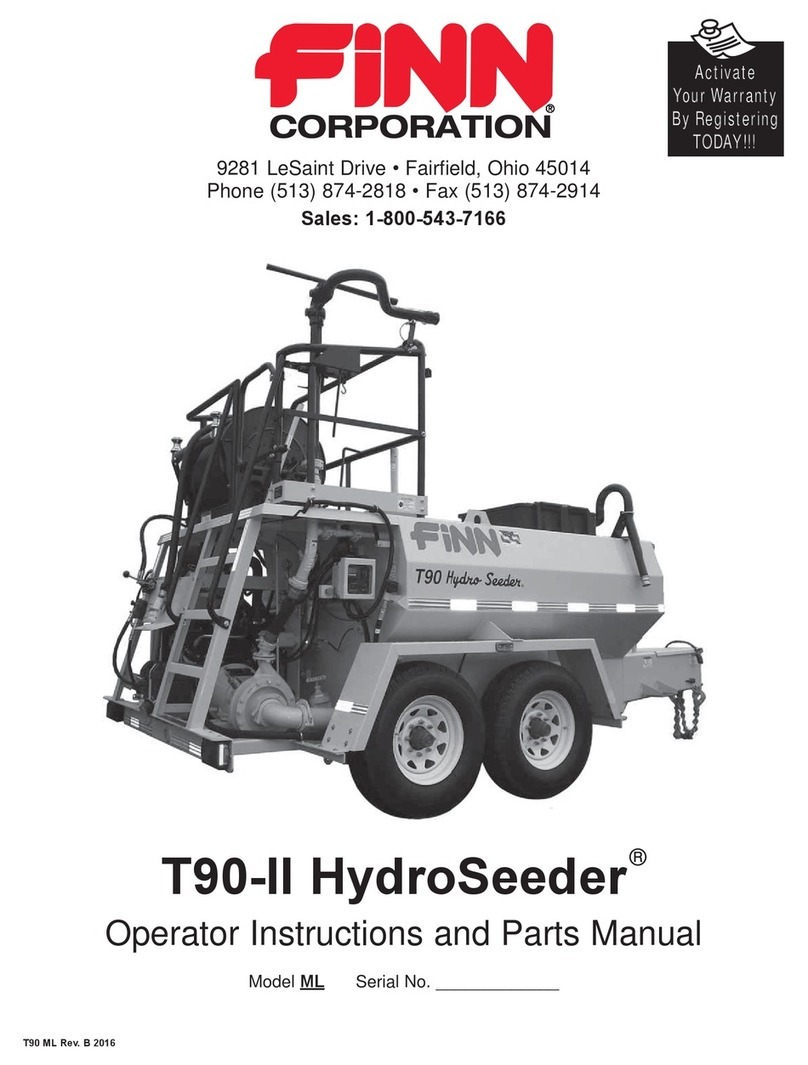
Finn
Finn T90-II HydroSeeder User manual and installation instructions

Progres
Progres AGRONIC 2500 user manual

